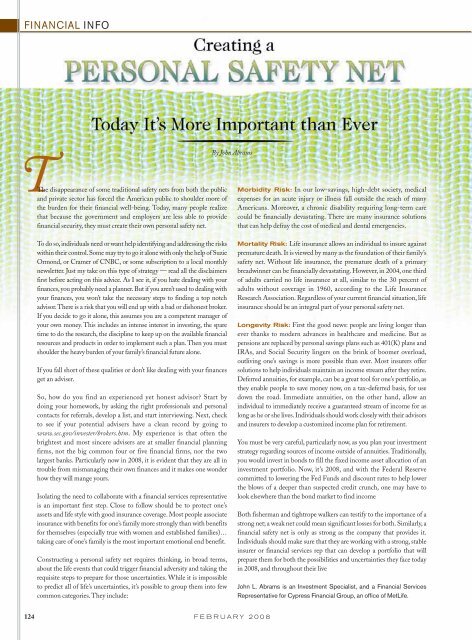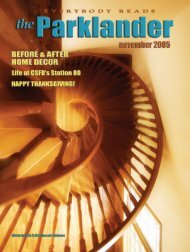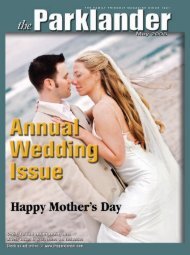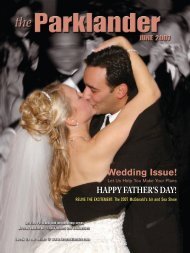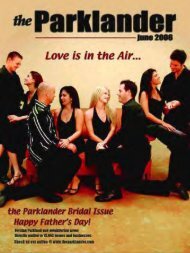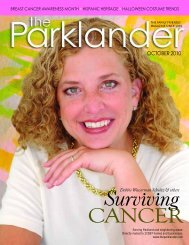February 2008 - The Parklander Magazine
February 2008 - The Parklander Magazine
February 2008 - The Parklander Magazine
- No tags were found...
You also want an ePaper? Increase the reach of your titles
YUMPU automatically turns print PDFs into web optimized ePapers that Google loves.
FINANCIAL INFOBy John Abrams<strong>The</strong> disappearance of some traditional safety nets from both the publicand private sector has forced the American public to shoulder more ofthe burden for their financial well-being. Today, many people realizethat because the government and employers are less able to providefinancial security, they must create their own personal safety net.To do so, individuals need or want help identifying and addressing the riskswithin their control.Some may try to go it alone with only the help of SuzieOrmond, or Cramer of CNBC, or some subscription to a local monthlynewsletter. Just my take on this type of strategy — read all the disclaimersfirst before acting on this advice. As I see it, if you hate dealing with yourfinances, you probably need a planner. But if you aren’t used to dealing withyour finances, you won’t take the necessary steps to finding a top notchadvisor.<strong>The</strong>re is a risk that you will end up with a bad or dishonest broker.If you decide to go it alone, this assumes you are a competent manager ofyour own money. This includes an intense interest in investing, the sparetime to do the research, the discipline to keep up on the available financialresources and products in order to implement such a plan. <strong>The</strong>n you mustshoulder the heavy burden of your family’s financial future alone.If you fall short of these qualities or don’t like dealing with your financesget an adviser.So, how do you find an experienced yet honest advisor? Start bydoing your homework, by asking the right professionals and personalcontacts for referrals, develop a list, and start interviewing. Next, checkto see if your potential advisers have a clean record by going towww.sec.gov/invester/brokers.htm. My experience is that often thebrightest and most sincere advisers are at smaller financial planningfirms, not the big common four or five financial firms, nor the twolargest banks. Particularly now in <strong>2008</strong>, it is evident that they are all introuble from mismanaging their own finances and it makes one wonderhow they will mange yours.Isolating the need to collaborate with a financial services representativeis an important first step. Close to follow should be to protect one’sassets and life style with good insurance coverage. Most people associateinsurance with benefits for one’s family more strongly than with benefitsfor themselves (especially true with women and established families)…taking care of one’s family is the most important emotional end benefit.Constructing a personal safety net requires thinking, in broad terms,about the life events that could trigger financial adversity and taking therequisite steps to prepare for those uncertainties. While it is impossibleto predict all of life’s uncertainties, it’s possible to group them into fewcommon categories.<strong>The</strong>y include:Morbidity Risk: In our low-savings, high-debt society, medicalexpenses for an acute injury or illness fall outside the reach of manyAmericans. Moreover, a chronic disability requiring long-term carecould be financially devastating. <strong>The</strong>re are many insurance solutionsthat can help defray the cost of medical and dental emergencies.Mortality Risk: Life insurance allows an individual to insure againstpremature death. It is viewed by many as the foundation of their family’ssafety net. Without life insurance, the premature death of a primarybreadwinner can be financially devastating. However, in 2004, one thirdof adults carried no life insurance at all, similar to the 30 percent ofadults without coverage in 1960, according to the Life InsuranceResearch Association. Regardless of your current financial situation, lifeinsurance should be an integral part of your personal safety net.Longevity Risk: First the good news: people are living longer thanever thanks to modern advances in healthcare and medicine. But aspensions are replaced by personal savings plans such as 401(K) plans andIRAs, and Social Security lingers on the brink of boomer overload,outliving one’s savings is more possible than ever. Most insurers offersolutions to help individuals maintain an income stream after they retire.Deferred annuities, for example, can be a great tool for one’s portfolio, asthey enable people to save money now, on a tax-deferred basis, for usedown the road. Immediate annuities, on the other hand, allow anindividual to immediately receive a guaranteed stream of income for aslong as he or she lives. Individuals should work closely with their advisorsand insurers to develop a customized income plan for retirement.You must be very careful, particularly now, as you plan your investmentstrategy regarding sources of income outside of annuities. Traditionally,you would invest in bonds to fill the fixed income asset allocation of aninvestment portfolio. Now, it’s <strong>2008</strong>, and with the Federal Reservecommitted to lowering the Fed Funds and discount rates to help lowerthe blows of a deeper than suspected credit crunch, one may have tolook elsewhere than the bond market to find incomeBoth fisherman and tightrope walkers can testify to the importance of astrong net; a weak net could mean significant losses for both. Similarly, afinancial safety net is only as strong as the company that provides it.Individuals should make sure that they are working with a strong, stableinsurer or financial services rep that can develop a portfolio that willprepare them for both the possibilities and uncertainties they face todayin <strong>2008</strong>, and throughout their liveJohn L. Abrams is an Investment Specialist, and a Financial ServicesRepresentative for Cypress Financial Group, an office of MetLife.124 FEBRUARY <strong>2008</strong>


